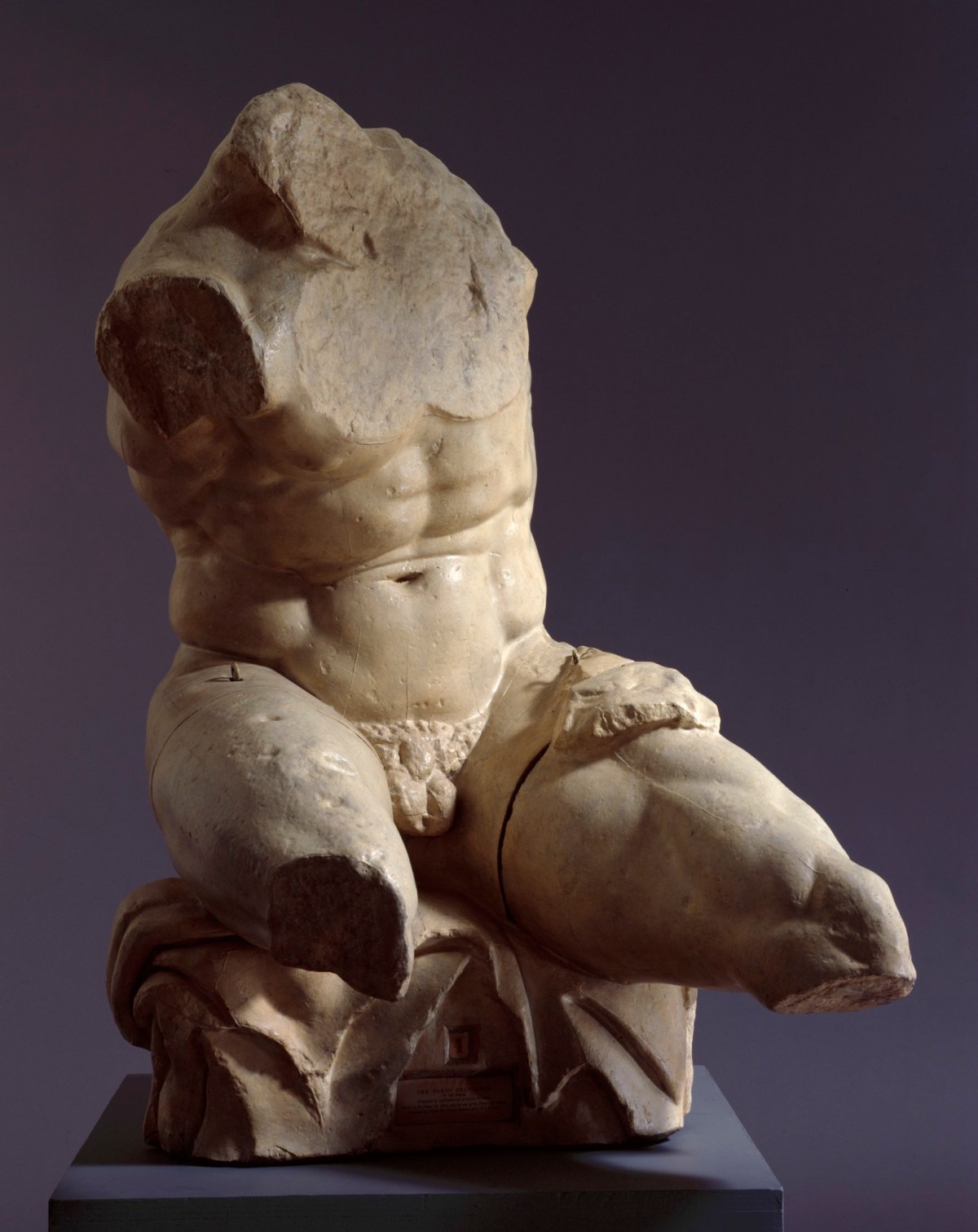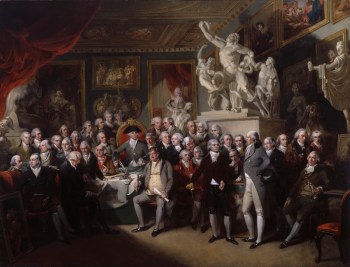
Cast of Belvedere Torso
Plaster cast, early 19th century. 1270 mm x 780 mm x 900 mm. © Photo: Royal Academy of Arts, London. Photographer: Paul Highnam.
This image is not available to download. To licence this image for commercial purposes, contact our Picture Library at picturelibrary@royalacademy.org.uk
Cast of Belvedere Torso
RA Collection: Art
On free display in Collection Gallery
A muscular figure a man seated on a rock, headless and limbless. The upper torso bending forward, to the right, where perhaps a right arm was leaning on the thigh, while the rest of the body turns vigorously on the left.
This powerful piece of sculpture is an eighteenth century cast of the Belvedere Torso in the Vatican. The sculpture is recorded as being in the collection of Cardinal Colonna between 1432 and 1435. It is possible that the sculpture was sold on to a sculptor and collector of antiquities, Andrea Bregno, who also lived in the region of Monte Cavallo. Bregno died in 1506 and the next reference to the Belvedere Torso is that it was in the statue court of the Belvedere. It moved into a small room and surrounded by railings early in the reign of Pope Clement XI and then placed in the round vestibule of the Museo Pio-Clementino in the 1770s. The sculpture was ceded to the French in 1797 under the terms of the Treaty of Tolentino and was part of the triumphal procession into Paris in 1798. It was displayed in the Musée Central des Arts from 1800. It was removed in October 1815 and arrived back in Rome on 4 January 1816 and was returned to the Vatican Museum by the end of February.
The torso is believed to be copy by Apollonius of a Greek bronze original dating from the 2nd century BC. The subject, indecipherable due to its fragmentary state, has uncertainly been identified as Hercules, owing to the massiveness of the figure and the animal skin spread over the stone seat thought to be that of a lion.
The torso was highly admired in the Renaissance for its powerful modelling, becoming an object of artists’ inspiration and veneration. It served as a model for many of Michelangelo’s figures in the Sistine Chapel, including the Sibyls and Prophets bordering the ceiling and the risen Christ in the Last Judgment. Michelangelo was fascinated by the torso’s fragmentary state, which he famously refused to restore, and which supposedly informing his own non-finito (unfinished) aesthetic.
Michelangelo's admiration for the work considerably increased its fame, and it continued to serve as an icon of artistic achievement for centuries afterwards.
The great German scholar Joachim Winckelmann (1717-1768) discussed the torso in his History of the Art of Antiquity, published in 1764. He wrote that ‘abused and mutilated in the extreme, deprived as it is of head, arms, and legs, this statue still appears, to those capable of looking into the mysteries of art, in a blaze of its former beauty. In this Herakles, the artist has figured in a high ideal of beauty raised above its nature, and a nature of virile maturity elevated to a state of divine contentment.’
In Britain meanwhile, Joshua Reynolds, in his ‘Tenth Discourse’ to Royal Academy students, celebrated the torso’s elemental structure, which he claimed to represent the perfection of the ‘science of abstract form’. Reynolds also stated of the work: 'A MIND elevated to the contemplation of excellence perceives in this defaced and shattered fragment, ... the traces of superlative genius, the reliques of a work on which succeeding ages can only gaze with inadequate admiration.' Its symbolic power was demonstrated in a Benjamin West self-portrait in which the artist painted himself besides the torso. In another work by Angelica Kauffman, meanwhile, the allegorical figure of Design sketched from the Torso.
British artists and scholars in the eighteenth century could have appreciated the Belvedere Torso through reproductive prints or plaster casts such as that in the RA collection. Since its foundation the Royal Academy collected copies of the torso for educational purposes. The opportunity to improve its cast collection arose in 1816 when the Royal Academy was presented by Prince Regent (later King George IV) with a superb group of twenty-six highly refined casts of the most renowned classical sculptures. These casts were presented to the Prince Regent as a gift from Pope Pius VII in gratitude for British diplomacy in facilitating the return of the original sculptures after they had been plundered by Napoleon.
Further reading
Sir Joshua Reynolds, 'Discourse X' in Discourses on Art, ed. R.R. Wark , Yale University Press, 1975, pp. 177-78
J.J. Winkelmann, History of the Art of Antiquity, tr. H.F. Mallgrave, Los Angeles, 2006
Supported by The Thompson Family Charitable Trust
Object details
1270 mm x 780 mm x 900 mm
Associated works of art
6 results
-
![Francesco Faraone Aquila, The Belvedere Torso]()
Francesco Faraone Aquila
The Belvedere Torso, 1704
Engraving with some etching
-
![Benjamin West PRA, Self-portrait of Benjamin West, P.R.A.]()
Benjamin West PRA
Self-portrait of Benjamin West, P.R.A., 1793
Oil on panel
-
![Angelica Kauffman RA, Design]()
Angelica Kauffman RA
Design, 1778-80
Oil on canvas
-
![Unidentified artist, The Private Sitting Room of Sir Thos. Lawrence]()
Unidentified artist
The Private Sitting Room of Sir Thos. Lawrence, December 1830
Aquatint and etching
-
![Henry Singleton, The Royal Academicians in General Assembly]()
Henry Singleton
The Royal Academicians in General Assembly, 1795
Oil on canvas
-
![Johann Zoffany RA, The Antique School of the Royal Academy at New Somerset House]()
Attributed to Johann Zoffany RA
The Antique School of the Royal Academy at New Somerset House, 1780-1783
Oil on canvas
Start exploring the RA Collection
- Explore art works, paint-smeared palettes, scribbled letters and more...
- Artists and architects have run the RA for 250 years.
Our Collection is a record of them.









